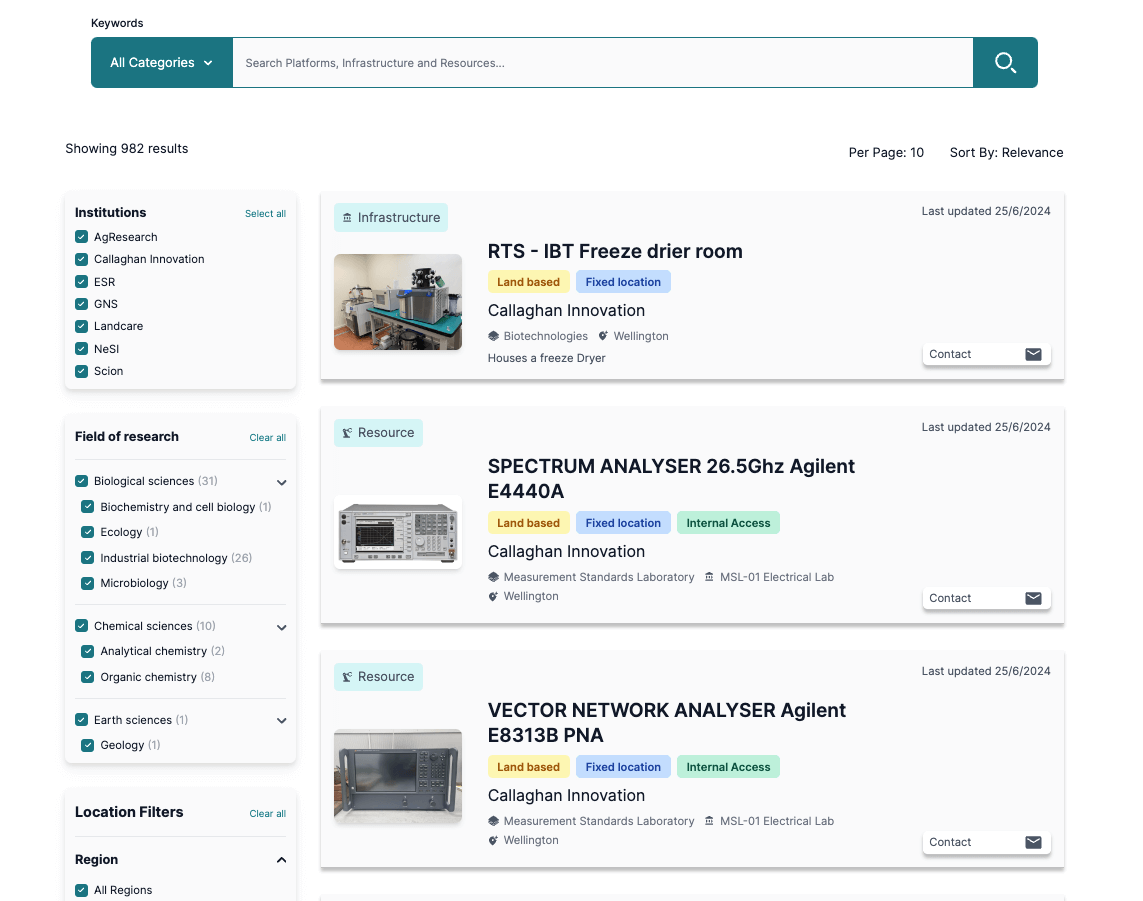Empowering New Zealand's Science Reform
Co-developed and designed by Callaghan Innovation and MBIE, Kitmap represents a collaborative effort to streamline access to research resources and foster a culture of innovation and collaboration in New Zealand's R&D ecosystem.


Kitmap Portfolio
The infrastructure portfolio across the institutions is characterised by large numbers of laboratories, each housing a variety of equipment and resources.
The remainder of the infrastructure portfolio is composed mainly of field sites, physical and digital collections, computational resources, and networks of sensors for monitoring the natural environment.
Research vessels make up only a small proportion of the research infrastructure portfolio, though these are in high demand and enable a variety of fields of research.
The largest fields of research enabled by research infrastructures are those supporting the agricultural and primary sectors and across the earth and environmental sciences, which is in line with the core purposes of the institutions surveyed.
Infrastructure Types
- Laboratory
Conventional laboratory rooms/buildings - Field Site
Physical Spaces used for research activities which are not conventional scientific laboratories (not only sites at which field work is carried out) - Livestock Facilities
Physical spaces for rearing, containing, or conducting research with livestock (including farm animals, fish, and insects) - Vessel
Ships or boats which are equipped to enable research to be conducted at sea - Digital Collection
Online databases and digital archives - Computing
Physical computing hardware and/or virtual spaces and networks - Workshop
Physical spaces which support research activities through fabrication/maintenance of research equipment - Other
Infrastructures whose main designation/purpose does not match the previous categories - Sample Collection
Collection of physical specimens - Monitoring
Sets or networks of monitoring equipment - Pilot Plant
Production facilities which enable trials of new production technologies or products on a pre-commercial scale
Definitions
The Kitmap data dictionary considered information from the Common European Research Information Format (CERIF5) and classifications of research infrastructure from the MERIL and Catalogue of Research Infrastructure Services (CatRIS6) projects. The Kitmap survey which was used to form the foundation of the online tool, used a three-layer data model to categorise holdings within each institution, comprising platforms, infrastructures and resources. These are defined as follows:
- Platform
A collection of one or more infrastructures, with a shared strategic purpose or shared governance, colocation or another unifying feature (refers to groups of infrastructures and not SSIF platforms). - Resource
A significant scientific instrument, collection, or a piece of equipment used or maintained as a single entity. The survey set a threshold value for significant equipment of $150k by agreement with the institutions. - Institution
Government organisations make up a significant portion of external users of research infrastructure across the CRI’s, Callaghan Innovation and NeSI, including government agencies and the Crown Research institutes, which make up the largest grouping and degree of cooperation within Kitmap data. - Infrastructure
An individual laboratory/facility, eg a field site, specialised laboratory or set of equipment. - ANZSRC Codes
The Australian and New Zealand Standard Research Classification (ANZSRC) is the collective name for a set of three related classifications developed for use in the measurement and analysis of research and experimental development (R&D) undertaken in Australia and New Zealand. Find more information here.
Optimising your search
The keyword search and filters on our Equipment and Infrastructure Directory can be used alone or in combination. A keyword search offers the most efficient method for finding terms related to research capabilities, infrastructure, equipment, functionality, fields of research, regions, or other specific criteria not covered by the filters. When combining keywords with filters, begin by entering your keyword(s) into the search bar and clicking “Search.” Once your keyword search is complete, you can further refine your results by selecting one or more filters or drop down menus to narrow down by region, institution, or field of research. Additionally, you have the flexibility to choose multiple items within each filter category.
- Abbreviations and ANZSRC Codes
Utilize widely known abbreviations, acronyms and brand names, as well as ANZSRC codes to enhance your search efficiency. - ANZSRC Codes
The Australian and New Zealand Standard Research Classification (ANZSRC) is the collective name for a set of three related classifications developed for use in the measurement and analysis of research and experimental development (R&D) undertaken in Australia and New Zealand. Find more information here. - Keywords
Consider incorporating technical terminology alongside business-oriented keywords to pinpoint the service or resource you require - Resource
Extend your search geographically to include other regions or institutions. In some cases, you won’t need to travel to the facility in person to take advantage of their services.
General Kitmap Questions
The infrastructure portfolio across the institutions is characterised by large numbers of laboratories, each housing a variety of equipment and resources. The remainder of the infrastructure portfolio is composed mainly of field sites, physical and digital collections, computational resources, and networks of sensors for monitoring the natural environment. Research vessels make up only a small proportion of the research infrastructure portfolio, though these are in high demand and enable a variety of fields of research. The largest fields of research enabled by research infrastructures are those supporting the agricultural and primary sectors and across the earth and environmental sciences, which is in line with the core purposes of the institutions surveyed.
Many but not all research infrastructures can be accessed by external users. The survey found that policies for access to infrastructure vary significantly across the institutions surveyed. All institutions enable some level of access to external users, with well over half of the infrastructures from most institutions being accessible to external users. In most cases institutions charge fees for access to external users, though some institutions make substantial infrastructure available at no cost. Access levels on the online platform are broken down into 3 categories: Internal access, Commercial Access (service), and open access. These are flagged on the listed items within the online tool.
The information for Kitmap was collected from the seven CRIs, plus Callaghan Innovation and NeSI, hereafter referred to collectively as the institutions. The information was gathered through a survey consisting of a spreadsheet with over 100 fields to be completed. The Kitmap team gratefully acknowledges the significant effort from the institutions in compiling detailed information about their infrastructure for this project. In addition to basic data about the institutions’ research infrastructures, the survey requested information on usage and access arrangements, funding sources, and the capabilities and fields of research which the infrastructures enable.
As the online Kitmap tool evolves, data will be continuously collected and updated via a designated dashboard accessible to contributing institutions. These institutions bear sole responsibility for ensuring the accuracy and currency of information on their Kitmap online profiles. To express your interest in becoming a contributor, please submit this form.
To reach out to infrastructure and equipment owners, simply utilize the online "enquire" buttons associated with each listed item. These buttons will direct you to an enquiry form where you can submit your questions or requests.
Our Kitmap team will then review and prioritize your enquiries, ensuring they are directed to the relevant platform owner for a prompt response. This centralized approach allows us to effectively manage user needs and mitigate risks associated with staff availability and turnover at platform facilities.
-
Make sure your problem or objective is clearly defined. What is your product, service or process-related challenge?
-
Consider how the platform facility could assist you in addressing these challenges. What specific support are you seeking, such as expertise, specialized infrastructure or equipment, or independent third-party testing/validation of a new product or process?
-
Note any timelines relevant to your project, such as major milestones or completion target dates that you hope to achieve.
-
Ask more about fee structures, intellectual property arrangements, and other applicable research policies and practices.
-
Utilize widely known abbreviations, acronyms and brand names, as well as ANZSRC codes to enhance your search efficiency.
-
Consider incorporating technical terminology alongside business-oriented keywords to pinpoint the service or resource you require. If you can’t find what you are looking for, feel free to reach out to the Kitmap team.
-
Extend your search geographically to include other regions or institutions. In some cases, you won’t need to travel to the facility in person to take advantage of their services.
Didn't find the answer? Ask the Kitmap team

